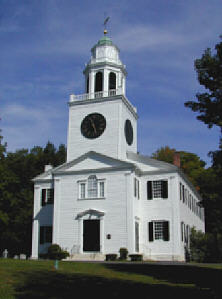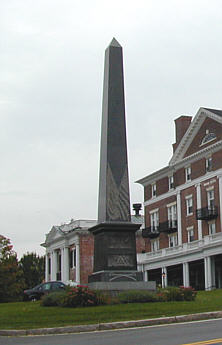LENOXMASSACHUSETTS |
 |
LENOXMASSACHUSETTS |
 |
 The
Church on the Hill was gathered in 1769 and there are several Revolutionary War
veterans buried in the churchyard, including Major General John Paterson and
Major Azariah Egleston. Both served the entire war and are memorialized on a
monument in the center of town.
The
Church on the Hill was gathered in 1769 and there are several Revolutionary War
veterans buried in the churchyard, including Major General John Paterson and
Major Azariah Egleston. Both served the entire war and are memorialized on a
monument in the center of town.
Paterson moved to Lenox shortly before the start of the war and helped to lead an effort to recruit and organize a regiment of minutemen from the Berkshires. He took over as commander of the regiment and led it throughout the war. One of the men he helped to recruit was Lenox resident, Azariah Egleston. Egleston began the war as a private and served in the regiment, completing his tour as a major. During his service, he married the regimental commander’s daughter, Hannah Paterson.
Paterson’s Berkshire regiment began the war near Boston and participated in a rear defensive action at the Battle of Bunker Hill (an upcoming site on this Revolutionary War Road Trip). After the British evacuated Boston, the regiment, consisting of about 600 men, participated in a disastrous attack on Canada. Many succumbed to small pox during the winter campaign. At the Battle of Cedars about 80 of Paterson’s men were taken prisoner and many were casualties.
After retreating from Canada, the regiment, now at a strength of only 220 men, joined General George Washington’s forces in Pennsylvania. Although Washington had been forced to retreat from the British across New Jersey after the Battle of New York City, the reinforcements from the Berkshires helped to redeem his reputation with the 1776 victory in Trenton and a later victory in Princeton.

|
In memory of Major General John Paterson Son of Colonel John Paterson. Born 1744, died 1808. And Elizabeth Lee, his wife, born 1749, died 1841. He was born in New Britain, Conn. Graduated at Yale College in 1762. He entered the law in his native town. He was married, June 2nd 1766. In 1774, he moved to Lenox and was chosen a member of the Berkshire Convention, July 1774. Represented this town in the General Court, which became the first Provincial Congress in 1774, and also in the Second Provincial Congress in 1775. Was made Colonel of a regiment he raised in 1775 and was one of the first in the field with it after the Battle of Lexington and defended Boston from an attack in the rear during the battle. Was complimented by Washington in General Orders, Nov. 10, 1775. In April 1776, was ordered to Staten Island and from there to Canada. Was in the Battle of the Cedars. Crossed the Delaware with Washington, Dec. 25, 1776 and was in the Battles of Trenton and Princeton. Was made Brigadier General, Feb. 21, 1777. Assisted in the capture of Burgoyne, October 1777, and was in the battle and council of Monmouth in 1778. In 1780, he commanded West Point and was on the trial of Major Andre. He was in most of the decisive battles of the Revolution and served during the whole war. He was one of the founders of the Society of the Cincinnati in May 1783 and on September 30, 1783, he was made Major General. After the war, he returned to Lenox and was a most public spirited citizen. In 1786, he commanded the Massachusetts troops in putting down Shays’ Rebellion. In 1790, he removed to Lisle, New York, where he died. He was four years a member of the New York General Assembly. In 1801, was a member of the committee to revise the constitution of New York State. Was appointed Chief Justice of Broome Co., N. Y. He served in the US Congress in 1803 to 1805. He died July 9, 1808 in the full vigor of manhood, in the pursuit of duty, in the service of the country he had so ably defended. He was a soldier, a patriot and a statesman. His remains lie in the churchyard. In gratitude for his public services and in recognition of his private virtues, this monument is erected. (Lenox Marker) |
In February of 1777, Paterson was promoted to Brigadier General and the regiment was attached to the Northern Department of Continental Army. There, they participated in the Battles of Saratoga (called the Battles of Bemis Heights on the monument in the center of town). At Saratoga, they helped to secure a victory that is called “the turning point of the war.”
The regiment continued to serve for the duration of the war. During the hard winter of 1777-1778 at Valley Forge, Egleston was promoted to officer’s rank as a Lieutenant. After Valley Forge, Egleston served with Paterson at the Battle of Monmouth and the siege of Newport, RI. He later served with Paterson when a detachment of Berkshire militia was ordered out to suppress the Shays’ Rebellion uprising. Both Paterson and Egleston continued to serve their country in public office after the war. Paterson served in the US Congress and Egleston in the State Senate.
Today, Egleston’s former home is the Birchwood Inn, a B&B at 7 Hubbard
Street, which is just east of the Church on the Hill.
The church also has an infamous connection to Shays’ Rebellion. Shays, along
with co-leader, Luke Day, and their army undertook an open rebellion against
what they considered an unfair tax burden levied by a state legislature under
the thumb of Boston merchants. The rebellion was deemed necessary to prevent the
state from seizing the farmers’ property for the payment of taxes they could
not meet.
Shays’ Rebellion is often considered the last battle of the Revolutionary War because it was the catalyst that caused the final pieces of the US Government to be put into place. Congress took notice of Shays’ Rebellion, leading it to create a Constitution that called for a strong, central government, one that could respond to Dec. 17 rebellion within individual states to maintain the integrity of all of the United States.
Shays’ Rebellion also produced the effect desired by the rebels in that it greatly influenced the public and its leaders. It helped create a Massachusetts government as well as a Federal government that was more responsive to the people. In Massachusetts, it also led to the election of a new, more popular governor, John Hancock.
Shays’ Rebellion was eventually suppressed. Two significant battles took place in Sheffield, near Great Barrington, and Springfield (both are upcoming sites on this Revolutionary War road trip).
Of the approximately 800 rebels that were captured during Shays’ Rebellion, eighteen were given death sentences, but only two were put to death. Both of these death sentences were carried out in Lenox. On December 6, 1787, John Bly and Charles Rose were taken to the church and reprimanded for their lawlessness. From the church, they were taken outside of town and put to death by hanging.
